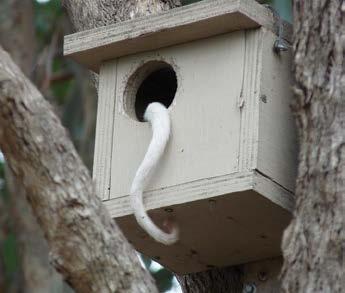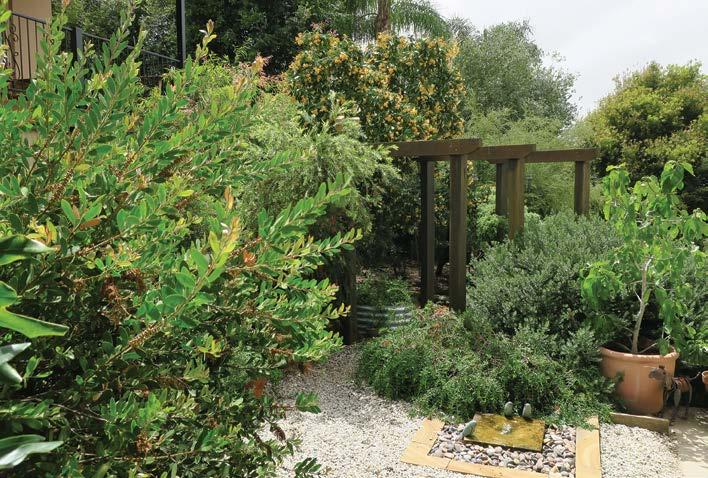
5 minute read
Creating your habitat garden
Habitat gardening … providing homes for our local wildlife
There are no hard and fast rules with designing a habitat garden, other than trying to mimic some natural conditions. Local wildlife will generally benefit most from native plants, but your garden doesn’t need to be exclusively native. Habitat gardens can be designed in different styles Many native animals depend on native and
Advertisement
- they can be formal, a riot of colour in a
Key elements of a habitat garden
cottage style, or an informal natural look. indigenous plants for food, shelter (from predators, competitors or the weather), and somewhere to breed safely. Likewise, plants benefit from animals through pollination, seed dispersal, pest control, waste breakdown and soil maintenance. Insects are vital for food for many animals.
A key to creating a habitat garden is to create structural diversity – lots of plants and lots of different layers. Aim to create a mix of trees, shrubs of varying heights, grasses and groundcovers.
If you are considering changing your garden quite a bit, a planned approach is important. Blitzing a garden may result in wildlife abandoning your garden for years, or being exposed and preyed upon if the intact vegetation is removed too quickly. Better to adopt a staged approach with patches of intact vegetation progressively replaced with new plants.
Dead trees also provide habitat for many of our native wildlife. Likewise, a few logs, rocks, mulch and leaves on the ground can provide habitat for many insects and lizards. Note that logs and rocks should not be sourced from local bushland where they are already providing habitat. If you live in a bushfire-prone area consider locating logs some distance from your house. Think about a variety of flowers – insects love daisies, honeyeaters love grevilleas but they also eat insects so insect-attracting plants are important, and finches eat seed. It’s time for gardens with lots of flowers to make a comeback - not just green hedges and green grass.
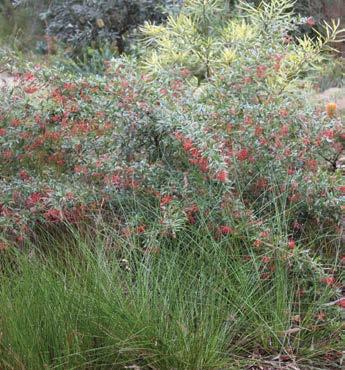
Layered garden
Garden layers

TREES Provide food and shelter for birds, possums, gliders, bats, goannas and insects.
SMALL TREES AND LARGE SHRUBS Habitat for birds, possums, gliders, goannas and insects.
SMALL SHRUBS Provide food and shelter for birds, possums, gliders, lizards and insects.
GRASSES AND GROUNDCOVERS Provide food and shelter for birds, lizards, frogs and insects.
LOGS, MULCH AND ROCKS Provides habitat for lizards, frogs and insects.
Plants that produce nectar, pollen, seeds, fruit, leaves and roots provide food for many of our native animals. Dead plant material can also be a source of food. Insects that live on the plants, mulch and soil in turn provide food for birds, lizards, frogs, mammals and other insects.
(For further information on plants to attract native wildlife, refer to pages 17-27 and pages 37-57). Some insects, such as butterflies, only lay their eggs on certain plants known as host plants. Most native caterpillars are small, shy and nocturnal leaving little evidence of their presence in your garden. If you want butterflies to visit your garden, include host plants such as Kangaroo Grass (Themeda triandra) for Common Browns or Everlasting Daisies (Xerochrysum species) for Painted Ladies.
Yellow-faced Honeyeater (NB)


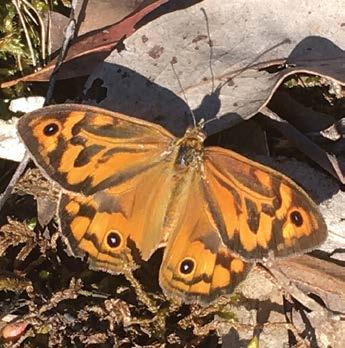
A reliable water source, particularly in summer, will help attract wildlife to your garden. A shallow birdbath on a pedestal next to a dense or prickly shrub will help protect birds from predators while they bathe and drink. Frogs need a permanent or semi-permanent water source to keep their skin moist and provide opportunities to breed. Butterflies love to gather on a wide dish of damp sand or a small puddle in the soil. They take in water and essential salts and minerals from the soil. A shallow dish of water at ground level will provide a much needed drink for echidnas and lizards on a hot day.
Striated Pardalote (DM)
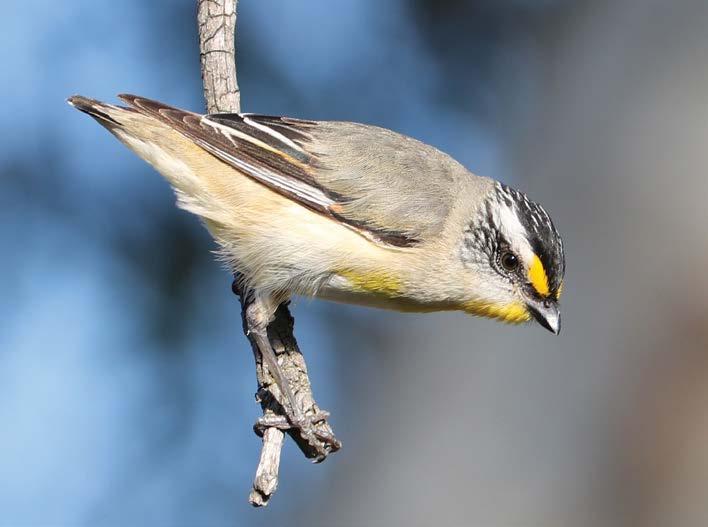

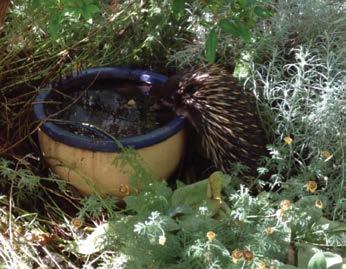
Native wildlife needs to find shelter from bad weather, predators, and competitors. They need a refuge in which to build their homes and raise their young. Prickly shrubs such as Hedge Wattle (Acacia paradoxa), grevilleas or Sweet Bursaria (Bursaria spinosa) and mature trees can provide homes for a large range of insect, bird and mammal species.
Tree hollows
Hollows are particularly important for nesting and breeding for many parrots, large birds, microbats and possums. Due to the clearing of old trees, there is now a shortage of hollows for many of our native mammals and birds. As a result, many species are finding it difficult to nest and breed. Consider adding nest boxes to your garden. Different species of native wildlife require different nest boxes.
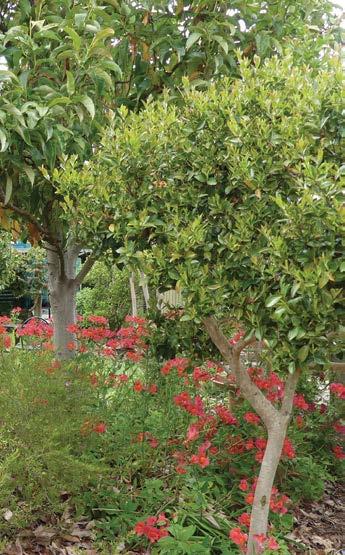
Shelter, Baranduda garden

Lizards, frogs and insects need the warmth of the sun to function. A large rock or log that receives the winter sun will be a welcome basking point for wildlife.
Responsible pet ownership
Ensure your efforts to attract native wildlife to your yard are not undone by pets such as cats and dogs. Try to limit or exclude pet access around habitat hotspots, like ponds, bird baths and lizard hang outs. Keep your pets, especially cats, inside during the night. Collar bells on cats have limited success, so containment is a better option. Consider creating a cat run.
Natural pest control
The greater the diversity of wildlife in your garden, the greater the natural pest control potential it will provide. Birds, bats, frogs, lizards, spiders and insects such as praying mantis all eat insects. Monitor your garden regularly, tolerate a minor infestation, remove pests such as snails by hand, or use exclusion netting to prevent fruit fly infestation. Herbicides, pesticides and fertilisers from our gardens can enter our stormwater system where they end up polluting our local waterways (or your own frog pond!) and harming plants and animals.
Encourage others
Invite your neighbours to create a habitat garden as well. This will attract more native wildlife to the whole area.
Sunny spot
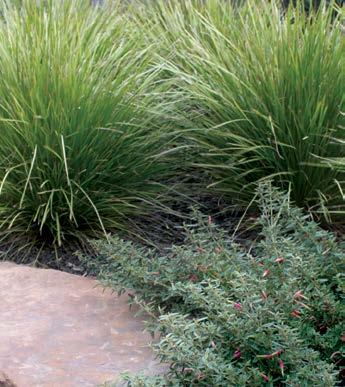

Grey Butcherbird with cricket (JS)
